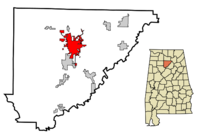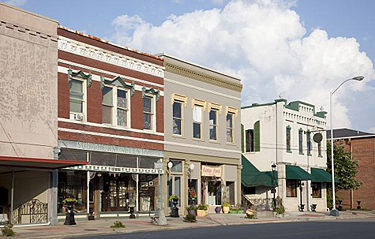Cullman
| City of Cullman | |

| |
| Incorporated | 1878 |
|---|---|
| Population | 15,858 |
| Mayor | Woody Jacobs |
| School district | Cullman City Schools |
| Government |
Cullman City Council |
| Web site | cullmancity.org |

| |
| Locate with Google Maps | |
Cullman (founded in 1873, incorporated in 1878) is a city of 15,858, the largest in and the seat of Cullman County. It is located on Brindley Mountain, accessed via I-65 about halfway between Birmingham and Huntsville. Cullman covers an area of 19.1 square miles, 95% dry land. Lake Catoma, within the city limits, provides the municipality's water supply.
The Mayor of Cullman, Woody Jacobs, and the five-member Cullman City Council work from Cullman City Hall at 204 2nd Avenue Northeast. The city operates the Cullman Fire Department, Cullman Police Department, Cullman Parks & Recreation Department, the Cullman Power Board, the Cullman Water Treatment Plant, Cullman Waste Water Treatment Plant, and the Cullman Municipal Court.
The City of Cullman jointly operates the Cullman Regional Airport–Folsom Field with Cullman County.
History
The present city lies along what was once the Black Warrior's Path, a trail which connected the present site of Florence on the Tennessee River to the Black Warrior River south of Cullman. Davy Crockett, then fighting for Andrew Jackson in the Creek Indian War, joined a contingent of troops which followed the trail.
On April 30, 1863, Day's Gap near the present location of Cullman was the site of a small battle between Confederate forces commanded by Nathan Bedford Forrest and Union troops commanded by Colonel Abel Streight. The US forces won the battle, but eventually surrendered to Forrest near the present site of Gaylesville in Cherokee County.
Three years later, Bavarian-born John Cullmann who emigrated to the United States, settling first in Cincinnati, Ohio, made a deal with the newly-opened Louisville and Nashville Railroad to promote settlement on a 349,000-acre tract around the present site of Cullman. He established a colony there with fifteen families of his fellow Cincinnatians. Soon, others were attracted to the growing town. A former military engineer, Cullmann laid out the town plan according to his training with 1/2-acre lots on rectangular blocks separated by 100-foot-wide streets.
Cullmann also founded a bilingual newspaper, Der Nord Alabama Colonist, and advertised the colony to Germans in other cities and in Europe. Some estimate that his activities brought as many as 100,000 European immigrants to the South. As president of the North Alabama Land and Immigration Company, he managed virtually all of the business conducted in the colony, including wine made from locally-grown grapes which he marketed under his Wine Company of Cullman. In 1877 the Alabama Legislature carved a new county from parts of Blount, Morgan, and Winston counties, centered on Cullman's fast-growing colony. He continued to act as the town's minister, doctor, judge, and agent until his death in 1895.
Cullman's primary economic activity at the beginning was agriculture. The region produced large quantities of corn, sweet potatoes, white potatoes, tomatoes, pole beans, lima beans and pimientos. By the 1950s poultry production was supplanting other crops. Other industries in the area included a King Edward Cigar Plant which was built in 1955, a King Pharr Foods cannery, Cullman Lingerie and the Cullman Products Corporation, a metal fabricator founded in 1959.
Cullman residents downplayed their German heritage during World War I and World War II, but since the 1960s, in anticipation of celebrating their centennial, the city has renewed interest in its cultural history. One example of German immigrant heritage that remained intact is religion, with prominent Catholic, Lutheran, and an Evangelical Protestant congregations.
Cullman established a sister city relationship with Frankweiler, Germany, Cullmann's home town, in 1987 and holds an annual Oktoberfest at its Festhalle Market Platz. Because Cullman County is dry, the city originally celebrated by drinking Oktoberzest (sparkling apple cider). The city voted to go "wet" in 2010, allowing for the first beer-fueled Oktoberfest celebration that year.
Long known as a "sundown town" that did not welcome African-Americans as residents, Cullman voters elected James Fields, a minister and unemployment office worker from The Colony, one of the county's few black enclaves, to the Alabama House of Representatives, representing the majority-white District 12.
Education
Cullman City Schools operates five schools: Cullman Primary School (Pre-K - 1st), Cullman East Elementary School (2-6), Cullman West Elementary School (2-6), John G. Cullman Middle School (7-8) and Cullman High School (9-12).
The Benedictine Society of Alabama, which had operated a preparatory school in Cullman since 1893, established Saint Bernard College in 1929. After expanding to a four-year curriculum in the mid-1950s it was accredited by the Southern Association of Colleges and Schools and merged with Cullman College to form Southern Benedictine College. The college closed in 1979, but was reopened as the St Bernard Preparatory School (9-12) in 1984. A St Bernard Middle School (7-8) and Sacred Heart Elementary School (Pre-K - 6) are also located in the city, as well as St Paul's Lutheran School (Pre-K-6)
Media
Cullman has a daily newspaper, The Cullman Times, and is served by four radio stations, WFMH (AM 1340), WMCJ (AM 1460), WKUL (FM 92.1), and WYDE (FM 101.1).
Attractions and notable institutions
Just south of Cullman is the St Bernard Abbey and its famed Ave Maria Grotto, an art installation begun in the monastery's former quarry by Brother Joseph Zoettl in 1912 and continuously expanded. The Cullman County Museum is housed in a replica of Cullmann's house erected in 1973 across the street from City Hall. The restored Cullman Depot, located in Depot Park on the CSX Railroad siding now houses the United Way of Cullman County. Other historical attractions include the Weiss Cottage and the Hubert Richter Memorial Chapel.
The City parks department operates a massive Cullman Wellness & Aquatic Center with an outdoor water park, indoor and outdoor competition and leisure pools and fitness center in Freeman Park. Other parks include the Cullman City Archery Park, Cullman Golf Course, Heritage Park, Hurricane Creek Park, Ingle Park, Cullman Municipal Tennis Courts, Nesmith Pool and several small passive parks.
The Cullman Regional Medical Center, an independently-operated 115-bed hospital, is located on Alabama State Highway 157 in the city. The regional Wal-Mart Cullman Distribution Center employs nearly 1,500 people.
Demographics
year pop. %change 1880 | 426 | - 1890 | 1,017 | +138.7% 1900 | 1,255 | + 23.4% 1910 | 2,130 | + 69.7% 1920 | 2,467 | + 15.8% 1930 | 2,786 | + 13.3% 1940 | 5,074 | + 82.1% 1950 | 7,523 | + 48.3% 1960 | 10,853 | + 44.3% 1970 | 12,601 | + 16.1% 1980 | 13,084 | + 9.5% 1990 | 13,367 | + 2.1% 2000 | 13,995 | + 4.7% 2010 | 14,775 | + 5.6% 2018 | 15,858 | + 7.3%
As of the 2010 census, there were 14,775 people and 6,957 households, out of which 22.5% had children under the age of 18 living with them, 48.3% were married couples living together, 10.7% had a female householder with no husband present, and 37.9% were non-families. 35.2% of all households were made up of individuals and 18.0% had someone living alone who was 65 years of age or older. The average household size was 2.22 and the average family size was 2.85. Cullman is 95% White, with 6.8% of the population Hispanic or Latino of any race.
The population density was 765.0 inhabitants per square mile, with 6,957 housing units at an average density of 365.1 per square mile. In the city the population was spread out with 21.8% under the age of 18, 8.2% from 18 to 24, 25.3% from 25 to 44, 22.6% from 45 to 64, and 22.1% who were 65 years of age or older. The median age was 41 years. For every 100 females there were 87.5 males. For every 100 females age 18 and over, there were 81.4 males.
The median income for a household in the city was $29,164, and the median income for a family was $41,313. Males had a median income of $32,863 versus $21,647 for females. The per capita income for the city was $18,484. About 9.4% of families and 13.2% of the population were below the poverty line, including 12.3% of those under age 18 and 18.5% of those age 65 or over.
Notable persons from Cullman
- JoJo Billingsley, singer/songwriter
- Wesley Britt, football player
- Jim Folsom Sr, Governor of Alabama 1947-1951 and 1955-1959
- Jim Folsom Jr, Governor of Alabama 1993-95, former and current Lieutenant Governor of Alabama
- Roger Hallmark, country musician
- Kurt Heinecke, composer and voice actor
- Charles Kleibacker, fashion designer
- Zeb Little, state senator
- Harold Martin, Pulitzer Prize-winning journalist
- William C. Martin, physicist
- Kassie Miller, singer/songwriter
- Frank Stitt, chef/restaurateur
- Channing Tatum, model and actor
- Holly Williams, country musician
- Larry Willingham, football player
| Cullman County | |
|---|---|
| Topics | |
| Cities |
Berlin | Baileyton | Colony | Cullman (seat) | Dodge City | Fairview | Garden City | Good Hope | Hanceville | Holly Pond | South Vinemont | West Point |
References
- Jones, Margaret Jean (1972) Combing Cullman County. Cullman, Alabama: Modernistic Printers
- Nossiter, Adam (February 21, 2008) "Race Matters Less in Politics of South." The New York Times
- Wiygul, Lauren (April 9, 2010) "Cullman". Encyclopedia of Alabama - accessed May 24, 2010
External links
- City of Cullman website
- History of Cullman at chs.cullmancats.net
